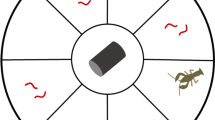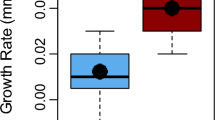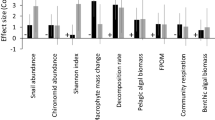Abstract
Biogeographical comparisons of native and non-native populations allow researchers to understand the degree to which traits contributing to invasion success are intrinsic or change during the invasion process. Here, we investigate whether traits underlying interspecific competition change following invasion and whether these alter the impacts of two crayfish congeners that have invaded into each other’s native ranges. Specifically, we compared native and non-native populations of rusty (Faxonius rusticus) and virile crayfish (F. virilis). We compared native and non-native populations of each species using laboratory assays to examine aggression and large mesocosms with the congeners in sympatry to examine growth and survival as well as impacts on lower trophic levels. We found that non-native virile crayfish were more aggressive in response to a threat than native virile crayfish and exhibited greater growth and survival in sympatry with rusty crayfish. These intraspecific differences were large enough to alter coexistence between species in the mesocosm experiment, which is consistent with patterns of coexistence between these species in the field. We did not observe differences in traits between native and non-native rusty crayfish, but rusty crayfish were consistently competitively dominant over virile crayfish in paired laboratory assays. Non-native populations of both species had greater impacts on lower trophic levels than native populations. Taken together, these findings provide new evidence that trait changes during invasions may enhance ecological impacts of invasive animals and their ability to compete with closely related native species.





Similar content being viewed by others
References
Bates D, Mächler M, Bolker B, Walker S (2014) Fitting linear mixed-effects models using lme4. arXiv 1406.5823
Berger-Tal O, Embar K, Kotler BP, Saltz D (2015) Everybody loses: intraspecific competition induces tragedy of the commons in Allenby’s gerbils. Ecology 96:54–61. https://doi.org/10.1890/14-0130.1
Bergman D, Moore PA (2003) Field observations of intraspecific agonistic behavior of two crayfish species, Orconectes rusticus and Orconectes virilis, in different habitats. Biol Bull 205:26–35. https://doi.org/10.2307/1543442
Bergman DA, Kozlowski CP, McIntyre JC, Huber R, Daws AG, Moore PA (2003) Temporal dynamics and communication of winner-effects in the crayfish, Orconectes rusticus. Behaviour 140(6): 805–825
Bergman DA, Redman CN, Fero KC, Simon JL, Moore PA (2006) The impacts of flow on chemical communication strategies and fight dynamics of crayfish. Mar Freshw Behav Physiol 39:245–258. https://doi.org/10.1080/10236240600980608
Blackburn TM, Pyšek P, Bacher S, Carlton JT, Duncan RP, Jarošík V, Wilson JR, Richardson DM (2011) A proposed unified framework for biological invasions. Trends Ecol Evol 26:333–339. https://doi.org/10.1016/j.tree.2011.03.023
Bossdorf O, Auge H, Lafuma L, Rogers WE, Siemann E, Prati D (2005) Phenotypic and genetic differentiation between native and introduced plant populations. Oecologia 144:1–11. https://doi.org/10.1007/s00442-005-0070-z
Bruski CA, Dunham DW (1987) The importance of vision in agonistic communication of the crayfish Orconectes rusticus. I: an analysis of bout dynamics. Behaviour 103:83–107. https://doi.org/10.1163/156853987X00288
Byers JE (2000) Competition between two estuarine snails: implications for invasions of exotic species. Ecology 81:1225–1239. https://doi.org/10.1890/0012-9658(2000)081[1225:CBTESI]2.0.CO;2
Capelli G, Munjal BL (1982) Aggressive interactions and resource competition in relation to species displacement among crayfish of the genus Orconectes. J Crustac Biol 2:486–492. https://doi.org/10.1163/1937240X82X00176
Charlebois PM, Lamberti GA (1996) Invading crayfish in a Michigan stream: direct and indirect effects on periphyton and macroinvertebrates. J N Am Benthol Soc 15:551–563. https://doi.org/10.2307/1467806
Crandall KA, De Grave S (2017) An updated classification of the freshwater crayfishes (Decapoda: Astacidea) of the world, with a complete species list. J Crustac Biol 37:615–653. https://doi.org/10.1093/jcbiol/rux070
Englund G, Krupa JJ (2000) Habitat use by crayfish in stream pools: influence of predators, depth and body size. Freshw Biol 43:75–83. https://doi.org/10.1046/j.1365-2427.2000.00524.x
Garvey JE, Stein RA (1993) Evaluating how chela size influences the invasion potential of an introduced crayfish (Orconectes rusticus). Am Midl Nat 129:172–181. https://doi.org/10.2307/2426446
Garvey JE, Stein RA, Thomas HM (1994) Assessing how fish predation and interspecific prey competition influence a crayfish assemblage. Ecology 75:532–547. https://doi.org/10.2307/1939556
Gherardi F, Barbaresi S, Raddi A (1999) The agonistic behaviour in the red swamp crayfish, Procambarus clarkii: functions of the chelae. Freshw Crayfish 12:233–243
Gioria M, Osborne BA (2014) Resource competition in plant invasions: emerging patterns and research needs. Front Plant Sci 5:1–21. https://doi.org/10.3389/fpls.2014.00501
Glon MG, Larson ER, Reisinger LS, Pangle KL (2017) Invasive dreissenid mussels benefit invasive crayfish but not native crayfish in the Laurentian Great Lakes. J Great Lakes Res 43:289–297. https://doi.org/10.1016/j.jglr.2017.01.011
Green PT, Lake PS, O’dowd DJ (2004) Resistance of island rainforest to invasion by alien plants: influence of microhabitat and herbivory on seedling performance. Biol Invasions 6:1–9. https://doi.org/10.1023/B:BINV.0000010144.12808.cb
Grosholz ED, Ruiz GM (2003) Biological invasions drive size increases in marine and estuarine invertebrates. Ecol Lett 6:700–705. https://doi.org/10.1046/j.1461-0248.2003.00495.x
Hierro JL, Maron JL, Callaway RM (2005) A biogeographical approach to plant invasions: the importance of studying exotics in their introduced and native range. J Ecol 93:5–15. https://doi.org/10.1111/j.0022-0477.2004.00953.x
Hill AM, Lodge DM (1999) Replacement of resident crayfishes by an exotic crayfish: the roles of competition and predation. Ecol Appl 9:678–690. https://doi.org/10.1890/1051-0761(1999)009[0678:RORCBA]2.0.CO;2
Hill AM, Sinars DM, Lodge DM (1993) Invasion of an occupied niche by the crayfish Orconectes rusticus: potential importance of growth and mortality. Oecologia 94:303–306. https://doi.org/10.1007/BF00317102
Holway DA, Suarez AV (1999) Animal behavior: an essential component of invasion biology. Trends Ecol Evol 14:328–330. https://doi.org/10.1016/S0169-5347(99)01636-5
Hulme PE, Bacher S, Kenis M, Klotz S, Kühn I, Minchin D, Nentwig W, Olenin S, Panov V, Pergl J, Pyšek P, Roques A, Sol D, Solarz W, Vilà M (2008) Grasping at the routes of biological invasions: a framework for integrating pathways into policy. J Appl Ecol 45:403–414. https://doi.org/10.1111/j.1365-2664.2007.01442.x
Human KG, Gordon DM (1996) Exploitation and interference competition between the invasive Argentine ant, Linepithema humile, and native ant species. Oecologia 105:405–412. https://doi.org/10.1007/BF00328744
Human KG, Gordon DM (1999) Behavioral interactions of the invasive Argentine ant with native ant species. Insectes Soc 46:159–163. https://doi.org/10.1007/s000400050
Joshi J, Vrieling K (2005) The enemy release and EICA hypothesis revisited: incorporating the fundamental difference between specialist and generalist herbivores. Ecol Lett 8:704–714. https://doi.org/10.1111/j.1461-0248.2005.00769.x
Kilian JV, Becker AJ, Stranko SA, Ashton M, Klauda RJ, Gerber J, Hurd M (2010) The status and distribution of Maryland crayfishes. Southeast Nat 9:11–32. https://doi.org/10.1656/058.009.s302
Kolar CS, Lodge DM (2001) Progress in invasion biology: predicting invaders. Trends Ecol Evol 16:199–204. https://doi.org/10.1016/S0169-5347(01)02101-2
Kuznetsova A, Brockhoff PB, Christensen RHB (2016) lmerTest: tests in linear mixed effects models. R package version 2.0-33
Lee CE (2002) Evolutionary genetics of invasive species. Trends Ecol Evol 17:386–391. https://doi.org/10.1016/S0169-5347(02)02554-5
Lenth RV (2016) Least-squares means: the R package lsmeans. J Stat Softw 69:1–33
Levine JM, Adler PB, Yelenik SG (2004) A meta-analysis of biotic resistance to exotic plant invasions. Ecol Lett 7:975–989. https://doi.org/10.1111/j.1461-0248.2004.00657.x
Lodge DM, Kratz TK, Capelli GM (1986) Long-term dynamics of three crayfish species in Trout Lake, Wisconsin. Can J Fish Aquat Sci 43:993–998. https://doi.org/10.1139/f86-122
Lodge DM, Williams S, MacIsaac HJ, Hayes KR, Leung B, Reichard S, Mack RN, Moyle PB, Smith M, Andow DA, Carlton JT, McMichael A (2006) Biological invasions: recommendations for US policy and management. Ecol Appl 16:2035–2054. https://doi.org/10.1890/1051-0761(2006)016[2035:BIRFUP]2.0.CO;2
Mccarthy JM, Hein CL, Olden JD, Jake Vander Zanden M (2006) Coupling long-term studies with meta-analysis to investigate impacts of non-native crayfish on zoobenthic communities. Freshw Biol 51:224–235. https://doi.org/10.1111/j.1365-2427.2005.01485.x
Moore PA (2007) Agonistic behavior in freshwater crayfish: the influence of intrinsic and extrinsic factors on aggressive behavior and dominance. In: Emmett DJ, Thiel M (eds) Evolutionary ecology of social and sexual systems: crustacea as model organisms. Oxford University Press, Oxford, pp 90–114
Moore PA, Bergman DA (2005) The smell of success and failure: the role of intrinsic and extrinsic chemical signals on the social behavior of crayfish. Integr Comp Biol 45:650–657. https://doi.org/10.1093/icb/45.4.650
Olden JD, McCarthy JM, Maxted JT, Fetzer WW, Vander Zanden MJ (2006) The rapid spread of rusty crayfish (Orconectes rusticus) with observations on native crayfish declines in Wisconsin (USA) over the past 130 years. Biol Invasions 8:1621–1628. https://doi.org/10.1007/s10530-005-7854-2
Olsen TM, Lodge DM, Capelli GM, Houlihan RJ (1991) Mechanisms of impact of an introduced crayfish (Orconectes rusticus) on littoral congeners, snails, and macrophytes. Can J Fish Aquat Sci 48:1853–1861. https://doi.org/10.1139/f91-219
Perry WL, Lodge DM, Lamberti GA (2000) Crayfish (Orconectes rusticus) impacts on zebra mussel (Dreissena polymorpha) recruitment, other macroinvertebrates and algal biomass in a lake-outlet stream. Am Midl Nat 144:308–316. https://doi.org/10.1674/0003-0031(2000)144[0308:CORIOZ]2.0.CO;2
Peters JA, Lodge DM (2013) Habitat, predation, and coexistence between invasive and native crayfishes: prioritizing lakes for invasion prevention. Biol Invasions 15:2489–2502. https://doi.org/10.1007/s10530-013-0468-1
Phillips BL, Brown GP, Shine R (2010) Life-history evolution in range-shifting populations. Ecology 91:1617–1627. https://doi.org/10.1890/09-0910.1
Pintor LM, Sih A (2009) Differences in growth and foraging behavior of native and introduced populations of an invasive crayfish. Biol Invasions 11:1895–1902. https://doi.org/10.1007/s10530-008-9367-2
Pintor LM, Sih A, Bauer ML (2008) Differences in aggression, activity and boldness between native and introduced populations of an invasive crayfish. Oikos 117:1629–1636. https://doi.org/10.1111/j.1600-0706.2008.16578.x
Pyšek P, Křivánek M, Jarošík V (2009) Planting intensity, residence time, and species traits determine invasion success of alien woody species. Ecology 90:2734–2744. https://doi.org/10.1890/08-0857.1
R Core Team (2016) R: A language and environment for statistical computing. R Foundation for Statistical Computing, Vienna, Austria. https://www.R-project.org/. Accessed 1 May 2016
Rehage JS, Sih A (2004) Dispersal behavior, boldness, and the link to invasiveness: a comparison of four Gambusia species. Biol Invasions 6:379–391. https://doi.org/10.1023/B:BINV.0000034618.93140.a5
Reisinger LS, Elgin AK, Towle KM, Chan DJ, Lodge DM (2017) The influence of evolution and plasticity on the behavior of an invasive crayfish. Biol Invasions 19:815–830. https://doi.org/10.1007/s10530-016-1346-4
Rubenstein DI, Hazlett BA (1974) Examination of the agonistic behaviour of the crayfish Orconectes virilis by character analysis. Behaviour 50:193–215. https://doi.org/10.1163/156853974X00453
Rutherford PL, Dunham DW, Allison V (1995) Winning agonistic encounters by male crayfish Orconectes rusticus (Girard) (Decapoda, Cambaridae): chela size matters but chela symmetry does not. Crustaceana 68:526–529
Sakai AK, Allendorf FW, Holt JS, Lodge DM, Molofsky J, With KA, Baughman S, Cabin RJ, Cohen JE, Ellstrand NC, McCauley DE, O’Neil P, Parker IM, Thompson JN, Weller SG (2001) The population biology of invasive species. Annu Rev Ecol Evol Syst 32:305–332. https://doi.org/10.1146/annurev.ecolsys.32.081501.114037
Sanders NJ, Gotelli NJ, Heller NE, Gordon DM (2003) Community disassembly by an invasive species. Proc Natl Acad Sci USA 100:2474–2477. https://doi.org/10.1073/pnas.0437913100
Sargent LW, Lodge DM (2014) Evolution of invasive traits in nonindigenous species: increased survival and faster growth in invasive populations of rusty crayfish (Orconectes rusticus). Evol Appl 7:949–961. https://doi.org/10.1111/eva.12198
Schneider RAZ, Huber R, Moore PA (2001) Individual and status recognition in the crayfish, Orconectes rusticus: the effects of urine release on fight dynamics. Behaviour 138:137–153. https://doi.org/10.1163/15685390151074348
Seebacher F, Wilson RS (2007) Individual recognition in crayfish (Cherax dispar): the roles of strength and experience in deciding aggressive encounters. Biol Lett 3:471–474. https://doi.org/10.1098/rsbl.2007.0289
Shea K, Chesson P (2002) Community ecology theory as a framework for biological invasions. Trends Ecol Evol 17:170–176. https://doi.org/10.1016/S0169-5347(02)02495-3
Stein RA (1976) Sexual dimorphism in crayfish chelae: functional significance linked to reproductive activities. Can J Zool 54:220–227. https://doi.org/10.1139/z76-024
Suarez AV, Tsutsui ND, Holway DA, Case TJ (1999) Behavioral and genetic differentiation between native and introduced populations of the Argentine ant. Biol Invasions 1:43–53. https://doi.org/10.1023/A:1010038413690
Swecker CD, Jones TG, Donahue K II, McKinney D, Smith GD (2010) The extirpation of Orconectes limosus (Spinycheek crayfish) populations in West Virginia. Southeast Nat 9:155–164. https://doi.org/10.1656/058.009.s306
Torchin ME, Lafferty KD, Kuris AM (2001) Release from parasites as natural enemies: increased performance of a globally introduced marine crab. Biol Invasions 3:333–345. https://doi.org/10.1023/A:1015855019360
Tsutsui ND, Suarez AV, Holway DA, Case TJ (2000) Reduced genetic variation and the success of an invasive species. Proc Natl Acad Sci USA 97:5948–5953. https://doi.org/10.1073/pnas.100110397
Usio N, Azuma N, Larson ER, Abbott CL, Olden JD, Akanuma H, Takamura K, Takamura N (2016) Phylogeographic insights into the invasion history and secondary spread of the signal crayfish in Japan. Ecol Evol 6:5366–5382. https://doi.org/10.1002/ece3.2286
Van Kleunen M, Weber E, Fischer M (2010) A meta-analysis of trait differences between invasive and non-invasive plant species. Ecol Lett 13:235–245. https://doi.org/10.1111/j.1461-0248.2009.01418.x
Venables WN, Ripley BD (2002) Modern applied statistics with S, 4th edn. Springer, New York
Warton DI, Hui FKC (2011) The arcsine is asinine: the analysis of proportions in ecology. Ecology 92:3–10. https://doi.org/10.1890/10-0340.1
Wetzel RG, Likens GE (2000) Limnological analysis, 3rd edn. Springer, New York
Wickham H (2009) Ggplot2: elegant graphics for data analysis. Springer, New York
Acknowledgements
We thank the 2016 Central Michigan University (CMU) Great Lakes Summer Research Program students, students in the Pintor Lab at The Ohio State University (OSU), the University of Wisconsin-Madison’s Trout Lake Station Staff, Ying Guy and Rongyi Zhu for help with crayfish collection and husbandry, the CMU Biological Station staff for assistance with mesocosm setup and maintenance, Ray Clark of CMU for assistance with fabrication of experimental equipment, and two anonymous reviewers for their help in preparing this manuscript for publication. Funding provided to LMP and MGG by OSU’s School of Environment and Natural Resources and the Ohio Agricultural Research and Development Center and to LSR by CMU’s Institute for Great Lakes Research. This is contribution 100 of the Central Michigan University Institute for Great Lakes Research.
Author information
Authors and Affiliations
Corresponding author
Electronic supplementary material
Rights and permissions
About this article
Cite this article
Glon, M.G., Reisinger, L.S. & Pintor, L.M. Biogeographic differences between native and non-native populations of crayfish alter species coexistence and trophic interactions in mesocosms. Biol Invasions 20, 3475–3490 (2018). https://doi.org/10.1007/s10530-018-1788-y
Received:
Accepted:
Published:
Issue Date:
DOI: https://doi.org/10.1007/s10530-018-1788-y





